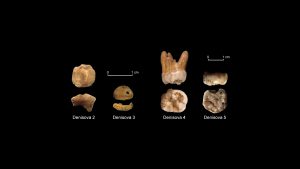
The Denisovans are a population of extinct hominins that likely lived between 400,000 years ago—when Denisovans and Neandertals split from human lineage—and 30,000 years ago. Fossil evidence for this species is dated to 130,000 to 75,000 years ago. Unlike the majority of the known hominin species who have numerous fossils representatives, they are known mainly from studies of their ancient DNA (aDNA). The first Denisovan specimen was identified when mitochondrial DNA (mtDNA) was extracted from the finger bone of a juvenile female found in Denisova Cave in the Altai Mountains of Siberia. Since then, there have been only a few fragmentary fossils found of this population, so consequently no new taxon has been proposed. Additionally, due to evidence of interbreeding between humans and Denisovans, some have suggested that they are not a new species and are instead a subspecies of Homo sapiens.
Since the publication of the first individual, bone fragments of more individuals from Denisova Cave have been found and had aDNA extracted and analyzed. Outside Denisova Cave, a couple of additional fossils have been found and attributed to the Denisovans: a tooth from a cave in Laos and a partial mandible (jaw bone) from a cave in China.
There is evidence the Denisovans may have interbred with Neandertals and Homo sapiens. Some groups of humans today have small amounts of Denisovan DNA, namely in people from Southeast Asia. A small, but significant, percentage of Denisovan DNA was from local populations, and recently, a first generation Denisovan/Neandertal hybrid was identified from a genetic analysis of a bone fragment from Denisova Cave.